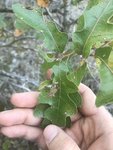@jbogard
This oak is spectacular enough that the reverse taper is forgivable. Once that area is exposed, slowly in time it will develop bark similar to the trunk above, but it will take decades. But like wild yamadori Ponderosa trunks, zones of reverse taper are usually ignored if the rest of the trunk is spectacular.
You should begin collecting oaks in order to learn how to do it. Start with smaller specimens. Collect a handful, just one or two of each species. Collect at different seasons of the year. Try defoliating trees as you collect them. Collect in spring, collect a few in summer, collect a few in autumn, collect in winter. Figure out what works. KEEP NOTES for yourself. It may take 3 to 5 years to figure out what combination of timing of collection, and style of aftercare will work for your local oaks. No reason to not start learning right now.
Once you get the collecting and after care of "medium quality" trunks down, then go for the more spectacular ones. Learning to collect is a hands on process, you need to do it to learn how to do it. Be deliberate in changing different factors, such as timing, and aftercare (bag or no bag, defoliate or no defoliate, the sunny side of the yard or the part shade). Once you develop a formula for success, go for the good trunks.










